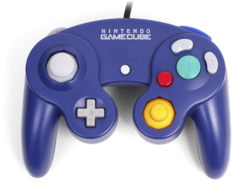Nintendo GameCube controller

Indigo GameCube controller
|
|
| Manufacturer | Nintendo |
|---|---|
| Type | Gamepad |
| Generation | Sixth generation |
| Release date |
|
| Input |
|
| Connectivity | GameCube controller port |
| Dimensions | 2.5 × 5.5 × 4 in; 6.5 ft cable 65 × 140 × 100 mm; 2 m cable |
| Predecessor | Nintendo 64 controller |
| Successor |
Wii Remote Classic Controller |
The GameCube controller (DOL-003) is the standard controller for the GameCube video game console.
Released alongside the GameCube console, the standard GameCube controller has a wing grip design. This controller was bundled with all new GameCube systems throughout the console's life cycle and was also available separately. It connects to the console's controller ports via a 2 m/6.5 ft cable.
The standard GameCube controller provides haptic feedback by way of a built-in rumble motor rather than using an external Rumble Pak add-on like the Nintendo 64 controller. Also unlike its predecessor, this controller does not feature any expansion capabilities.
The controller features a total of six digital buttons, two analog sticks, a d-pad and two hybrid analog triggers/digital buttons.
The primary analog stick is on the left, with the D-pad below it. The four face buttons are on the right of the controller (a large green "A" button in the center, a smaller red "B" button to its bottom left and two kidney-shaped buttons; "X" to the right and a "Y" to the top) with a yellow "C" stick below those. A Start/Pause button is located in the middle of the controller. On the "shoulders" of the controller there are two analog triggers marked "L" and "R," as well as one digital button marked "Z" which sits above the "R" trigger. The "L" and "R" triggers feature both analog and digital capabilities. Each of these behaves as a typical analog trigger until fully depressed, at which point the button "clicks" to register an additional digital signal. This method effectively serves to provide two functions per button without actually adding two separate physical buttons.
The GameCube controller was sold in several different colors over the console's lifespan. Standard colors included "Indigo" (Purple), "Jet Black", "Platinum" (Silver) and "Spice" (Orange); these were bundled with their respective colored GameCube consoles and sold separately in many countries. Other standard colors sold separately included "Indigo/Clear" (Indigo top with a clear translucent bottom), "Emerald Blue" (Turquoise), and White; the latter two were only available in Japan.
Nintendo released a number of limited edition controllers in Japan through Club Nintendo, which featured a unique color scheme and/or logo in the center. Club Nintendo controllers could be purchased for 500 points each and designs included "Mario" (red top and blue bottom), "Luigi" (green top and blue bottom), "Wario" (yellow top and purple bottom) and a "Club Nintendo" controller (white top and light blue bottom). The "Mario" design was also made available in limited quantities through the European Stars Catalogue for 5000 points.
...
Wikipedia
